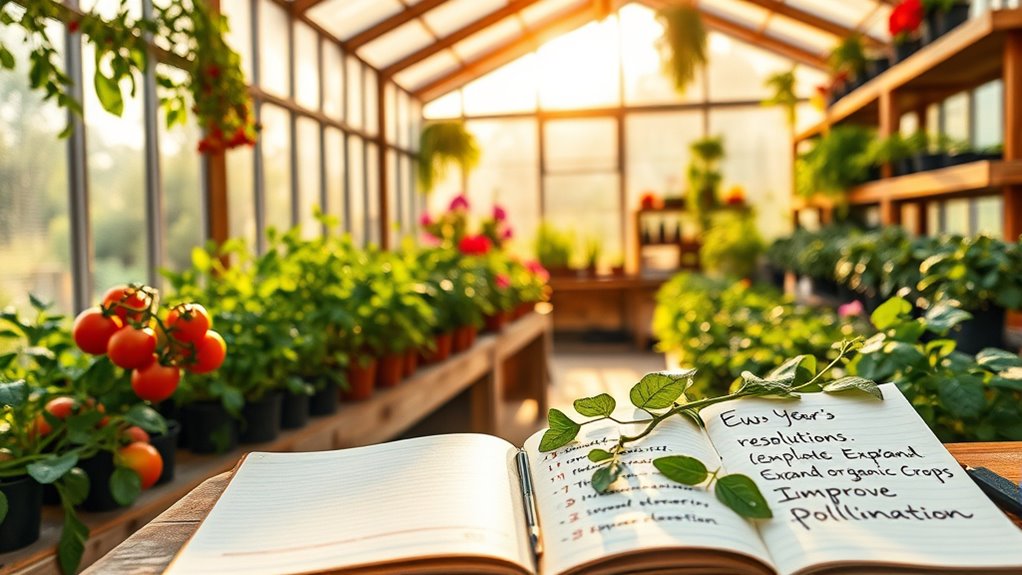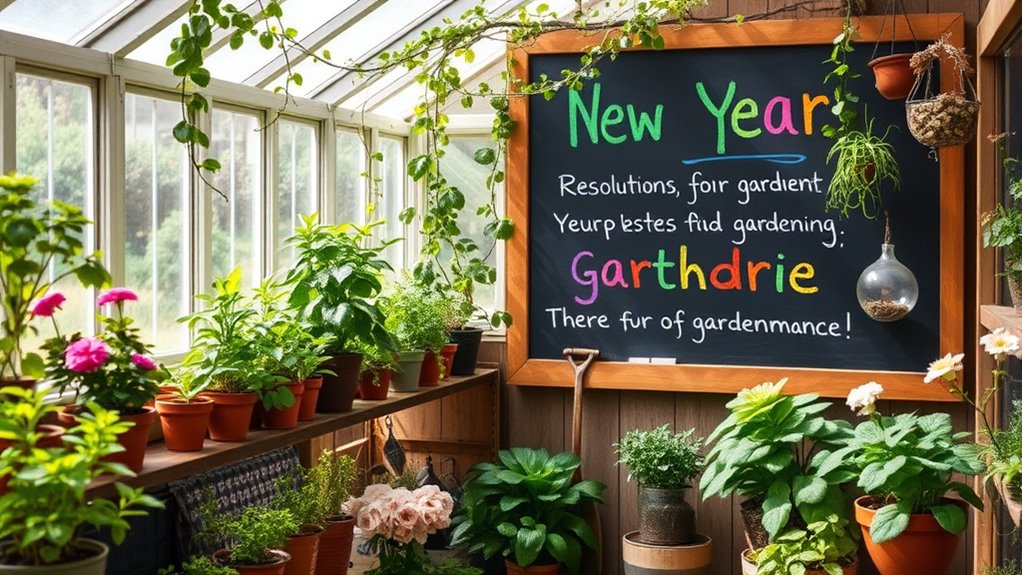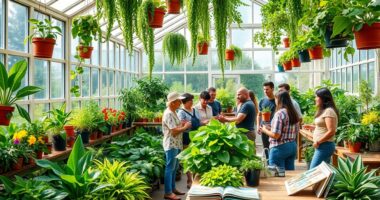In the new year, set clear goals for your greenhouse by prioritizing plant propagation, pest control, and environmental management. Aim to increase healthy plant production, diversify your plant varieties, and reduce pesticide use through integrated pest strategies. Regularly track your progress and adjust your plans to stay on course. By focusing on sustainable practices and continuous improvement, you’ll create a thriving, productive space. Keep going, and you’ll discover more tips to achieve success this year.
Key Takeaways
- Set measurable goals for plant propagation, pest control, and environmental improvements to track progress effectively.
- Develop a comprehensive pest management plan emphasizing biological controls and routine monitoring.
- Diversify plant varieties and experiment with new propagation techniques to enhance greenhouse productivity.
- Regularly review and adjust strategies based on performance data to ensure continuous improvement.
- Prioritize sustainability and well-being by maintaining discipline, celebrating progress, and supporting mental health.

Have you ever wondered how greenhouse owners set and achieve their environmental and productivity targets? It’s a combination of careful planning, consistency, and adapting to challenges that helps you reach your goals. One of the first steps is understanding your priorities—whether it’s expanding plant propagation efforts or minimizing pest issues. Setting clear, measurable targets ensures you stay focused throughout the year and can track your progress effectively. When it comes to plant propagation, your goal might involve increasing the number of healthy seedlings or new plants produced each season. To do this, you need to optimize conditions like light, humidity, and temperature, which directly influence germination rates and plant growth. You might also consider experimenting with new propagation techniques or expanding your varieties to diversify your offerings. By establishing specific targets—such as propagating 200 new plants per month—you create a concrete plan to improve your operation.
Pest management is another critical area where setting goals can dramatically impact your success. Pests can undermine your efforts by damaging plants, reducing yields, and spreading diseases, so creating a pest control strategy is essential. Your objectives could include reducing pesticide use through integrated pest management (IPM) practices, introducing beneficial insects, or implementing regular monitoring routines. Setting a goal to decrease pest-related damage by a certain percentage encourages you to stay vigilant with preventative measures and early interventions. Using scouting techniques, sticky traps, and biological controls helps you keep pest populations in check without harming the environment or your plants. When you actively monitor and document pest occurrences, you can adjust your strategies accordingly, aiming for a pest-free or minimally affected greenhouse. Additionally, understanding the importance of sleep and mental health can enhance your overall well-being, helping you stay focused and resilient in managing your greenhouse challenges.
Achieving these goals requires discipline and ongoing evaluation. Regularly reviewing your progress allows you to identify what’s working and where adjustments are needed. For example, if your plant propagation numbers aren’t meeting targets, you might need to fine-tune your environment or incorporate new techniques. Similarly, if pests persist despite your efforts, re-evaluating your pest management approach might be necessary. By setting achievable, specific goals around plant propagation and pest management, you create a roadmap that guides your daily activities and long-term improvements. This focused approach not only boosts productivity but also promotes a healthier, more sustainable greenhouse environment. Ultimately, your success depends on your ability to stay committed to your resolutions, learn from setbacks, and celebrate your progress along the way.
Frequently Asked Questions
How Can I Extend My Growing Season Effectively?
To extend your growing season effectively, start with season extension techniques like using row covers, cold frames, or hoop houses. These tools trap heat and protect crops during cooler months. Additionally, practice crop rotation to maintain soil health and reduce pests, ensuring your plants stay productive longer. Keep an eye on weather forecasts and adapt your methods accordingly, so you maximize your harvest and enjoy fresh produce year-round.
What Are the Best Sustainable Practices for Greenhouses?
You can embrace sustainable practices by using composting methods to enrich your soil naturally, reducing reliance on chemical fertilizers. Incorporate renewable energy sources like solar panels to power heating and lighting, decreasing your carbon footprint. Investigate the effectiveness of these methods firsthand, as many gardeners find that combining composting with renewable energy creates a more eco-friendly and cost-efficient greenhouse environment. This approach helps you grow healthy plants while protecting the planet.
How Do I Choose the Right Plants for My Climate?
You should consider plant compatibility and soil preparation to choose the right plants for your climate. Assess which plants thrive in your temperature, humidity, and sunlight levels, then select those suited to your local conditions. Prepare your soil by testing its pH and nutrients, adjusting as needed. This approach guarantees your plants will grow strong and healthy, giving you a thriving, sustainable greenhouse tailored perfectly to your climate.
What Are Common Pest Management Strategies?
Research shows biological controls are highly effective in pest management. You should regularly introduce beneficial insects like ladybugs or predatory mites to naturally reduce pest populations. Additionally, implementing crop rotation helps break pest life cycles and prevents buildup of specific pests in your soil. Combining these strategies creates an integrated approach that minimizes chemical use, keeping your greenhouse healthier and more sustainable.
How Can I Reduce Water Usage in Greenhouse Gardening?
You can reduce water usage in your greenhouse by installing drip irrigation, which delivers water directly to your plants’ roots, minimizing waste. Additionally, set up rainwater harvesting systems to collect and reuse rainwater, cutting down on tap water consumption. Combining these methods helps conserve water, lowers your utility bills, and promotes sustainable gardening practices. Regularly monitor soil moisture levels to avoid overwatering and optimize your watering schedule.
Conclusion
Just like tending a greenhouse, your gardening goals thrive with consistent care and patience. I once watched a novice gardener transform a struggling plant into a lush masterpiece by simply adjusting watering habits. Remember, small daily efforts compound over time—your green thumb can turn even the tiniest seeds into vibrant life. Stay committed this year, nurture your goals, and watch your garden—and confidence—bloom beyond your expectations. Every step forward plants the seeds for success.









